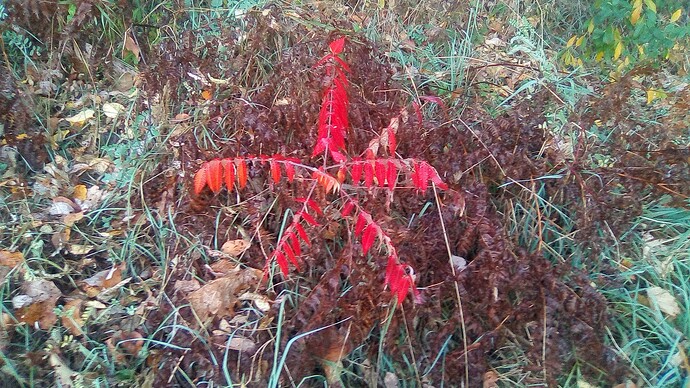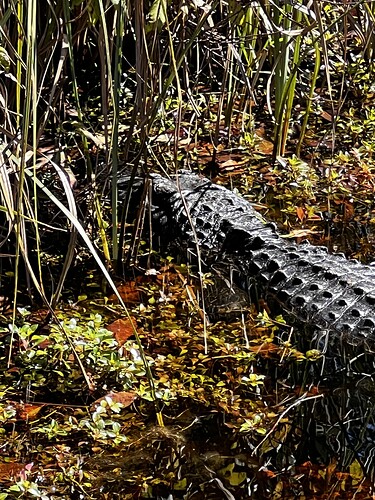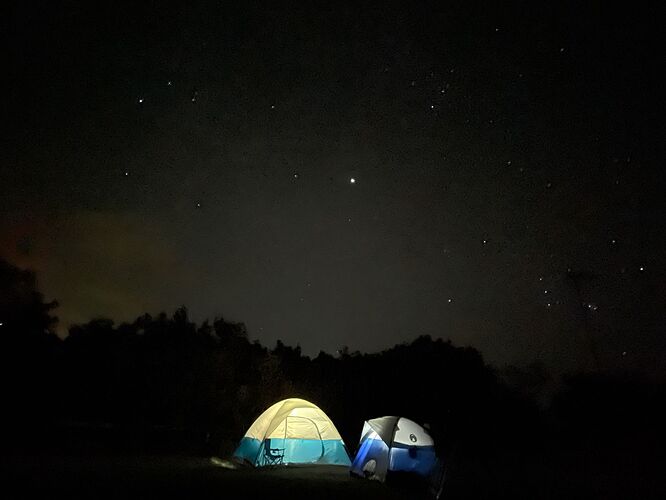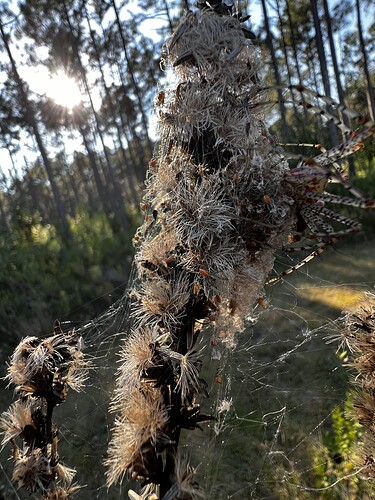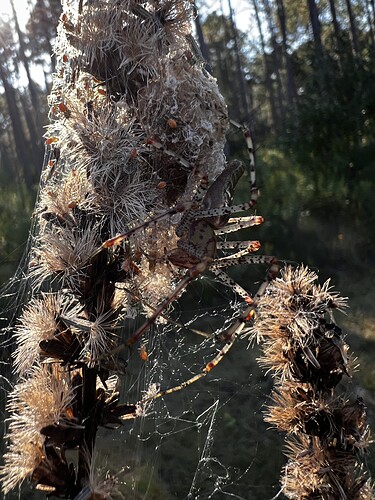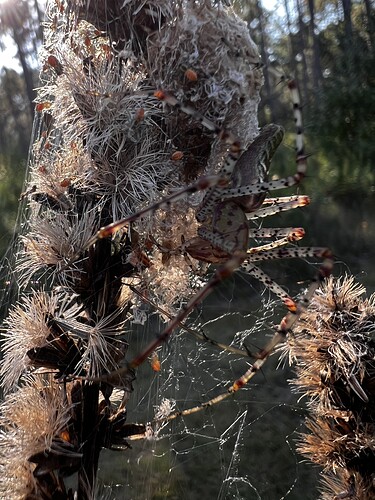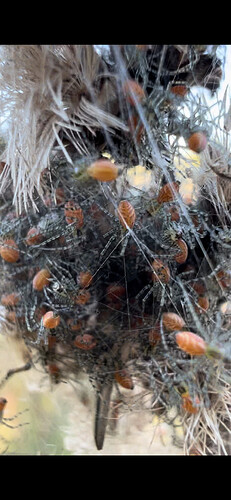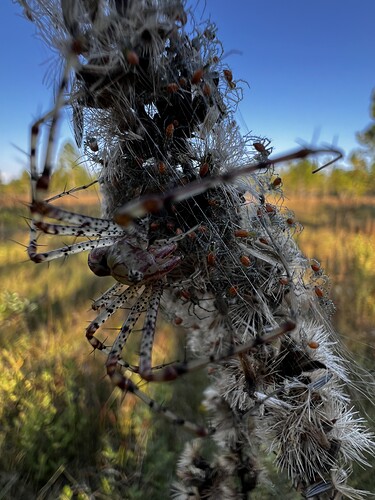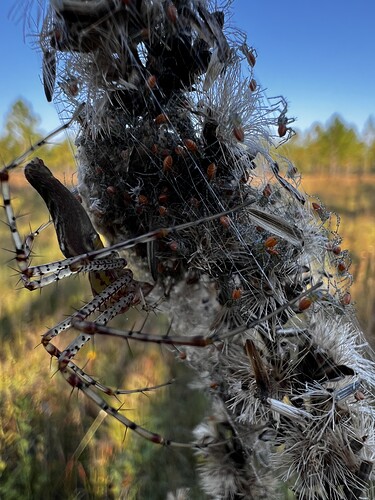Yeah often scared people holds them way too tightly. Or will hold them in ways that can cause them discomfort or harm. So never just hold them by the head and try to always hold as much of their body as possible. But don’t force them to curl into a shape. Keep everything but lose so they can move, unless it’s venomous. That changes how it’s handled or if it is even handled.
We keep having clouds piled up on the horizon too high, but I’ll keep hoping. And by piled high I mean the sun vanishes behind them forty minutes before sunset.
I have an interesting question for others on the thread. I should have taken a photo this morning, but unfortunately, I didn’t. I’ve been using a live trap for mice in our garage. To date, I’ve caught about 15! (My family suspect that I have been releasing the mice too close to the house (about 50 feet away, in the woods), and that they are just returning for the peanut butter smorgasbord).
This morning, I caught 2 animals, which appeared at first to both be mice. However, one was dead and half -eaten by the other. On closer inspection, the live one had bristly hair, much less prominent eyes, a rather predatory looking snout, and a shorter tail. I am pretty sure it was a shrew.
I Googled the question, “Do shrews eat mice,” and came up with a response from “A-Z Animals” that yes, indeed, they do. I’m rather surprised, and maybe even somewhat traumatized by this, but wonder if you have run into this before.
Thanks.
(copy of a photo I found that is quite close to what I saw):
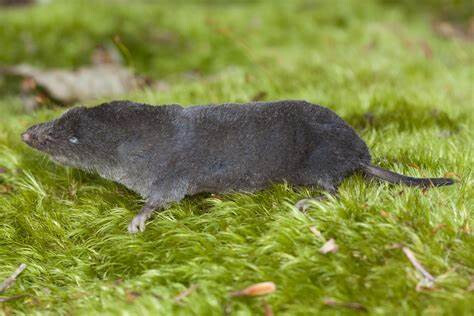
This is the type of live trap I am using (not the actual one).
Given that shrews will eat basically anything they can within a general dietary range, it’s not very surprising.
I am not familiar with shrews, but I hear they are hard to tame. And 50 ft is far too close.
There are several shrew species. The largest one, northern short-tailed shrew, can kill and eat mice and other small vertebrates. Smaller species eat dead mice but cannot usually kill a live one (many shrews are too small compared to mice - they would kill if they were larger).
When moving live mice from a house, you have to move them quite far. I moved some bank voles from a summer cottage years ago. If I moved them less than 150m, they could sometimes come back to the summer cottage faster than me - I had individual ear tags on them, so the identity was easy to reveal. Only when I moved them >300m (>330 yards), they did not return.
The return distance probably depends on the species and the terrain. Many species make regularly short excursions from their home range, so they may know the routes back to their home range.
Mice will also eat mice. My husband quit using live traps because he sometimes caught two mice in one trap and the results were grisly. He decided a swift blow to the back of the head was more humane than the fight to the death - red in tooth and claw.
It also helps if you relocate them to an area proven to support diverse wildlife, which you can judge by the number of feral cats around.
Thanks for all your input. I am afraid I will now start killing Reepicheep/Stuart Little, with sadness, but out of necessity.
Interestingly, my last trap yesterday caught another, rather large shrew.
An acquaintance got accused of the same, so he started taking them out into the center of a large field near dusk when hawks were about and hunting. He made sure he had the hawks’ attention, and then opened the trap.
So he got told he was making things too easy for the hawks!
But he hadn’t, not completely; there was also competition from snakes in the field.
Farmers here would say 100 yards is still too close.
When we first moved here, 17 years ago, we found raccoons in the attic. We trapped them and I transported them about 10 miles away, and let them go across the river. I suspect it was not necessarily the distance, but the fact that we patched up the hole we found in the roof (through which they had come) that prevented their return. I was hoping it would be harder for the mice, and that they would like the woods–but boy, I have to say I would prefer the warmer garage, too.
I remember 'coons in the attic. Our dad trapped and got rid of on batch, but we found out that at least one had returned one day as we were watching TV and from up above came a clatter-rattle-THUMP repeated several times, a sound we’d heard before – a raccoon pushing an old coffee can up the slope of an inner roof portion, pushing it over the little cross-beams.
My older brother and I conspired to find the access point, entering the attic at two different spots and lying silently in wait until we heard scratching at that can. We pinned the critter with flashlight beams; h froze then bolted and we tracked him. It was kind of impressive; he went down between two wall studs and vanished into a passage/gap that went all the way down to under the house where there was a broken end on a subfloor plank that gave access to the wall. So we put new insulation in the wall passage, closed the top end, closed the bottom, and insulated the attic while we were at it.
That didn’t get rid of them, it just kept them in the crawl space – which mom said was fine, it gave them a warm place for the winter. But the following summer we insulated the floor, cutting off the heat supply to under the house, and they didn’t return.
Or at least they didn’t return to the house; they found a spot under the utility shed which housed our well tap, the electric fence gear and controls, and bags of garden soil supplements. It was right next to the compost heap, which provided some heat of decomposition.
The most secure ways to prevent animals enter a building are to cover all potential holes with a metal mesh and reduce the amount of potential food in the area. Covering all holes with a metal mesh is easiest when building or renovating the building. After the building is finished, it may be too difficult or laborious to cover all holes.
For mice, the limit for entrance is the height of the skull. If the animal can get its head squeezed through the hole, the body follows. For small mice, a hole with a height of 7mm may be large enough for entrance. Larger ones may gnaw or chip away a hole if they have a reason to stay in the place - that is why the availability of food in the area is important.
I have handled mice, rats, voles, shrews, bats, squirrels, weasels, martens, woodpeckers and small birds entering and living in buildings. Bats and martens may be stinky and messy but the worst cases have been rats and squirrels because they gnaw holes through structures. We even renamed the red squirrels as thick-tailed rats after they gnawed seven new holes through the outer boards of our house during one winter. That happened despite I livetrapped squirrels and then released them far from the house during that winter. Collaboration between woodpeckers and squirrels has also been effective - a woodpecker makes a small hole in the wall, thereafter a squirrel gnaws the hole larger.
The most effective way to reduce such damage has been to stop winter feeding of small birds in the surroundings of the house. No food = no attraction to live in the place.
Small mammals may be surprisingly agile in getting to buildings. One wood mice climbed to an oak near a house and jumped on the building close to a spot where it had found a small entrance hole. Mice, shrews and even field vole run up on a vertical surface until they reached small holes beneath a roof where they could enter the building. Waching such stunts might be fun if these fellows would not cause damage.
Shrews and weasels are beneficial as they eat pests so I welcome these. Bats are also beneficial eaters of pests but may be problematic inside a house as a colony may produce quite much stinky output. Bats and humans typically live in different compartments of the building but the output might still be too much for the owners to tolerate the lodgers. Living in separate parts of the building is also important because bats may have diseases - not a problem if you do not need to handle bats or live in the same room.
A buddy of mine had a rat problem, and they chewed multiple holes in his pex plumbing, resulting in his needing to replumb his whole house. We were in the midst of a heat wave, but ironically he lives on the waterfront of a constant level lake, so they had a ready source of water only feet from the house. I guess they preferred indoor plumbing.
Took my son camping this weekend with the Boy Scouts and it was wonderful
(would have had more tents in the night shot if the picture was taken a little earlier)
Nice! Love Orion. Just wish Betelgeuse would pop sooner rather than later, while I am still around.



